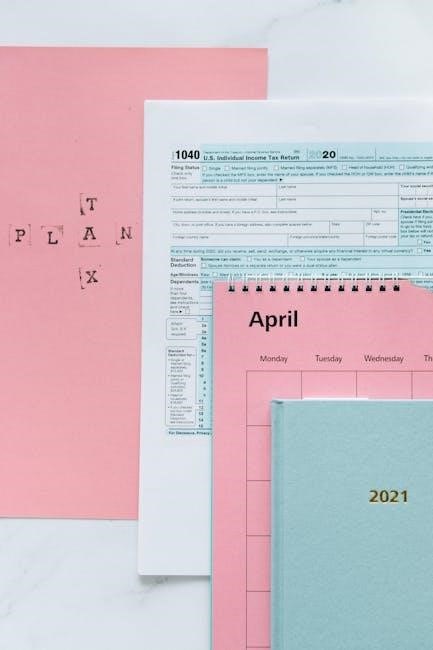Year 3 spelling words are essential for building foundational literacy skills․ These words include high-frequency and statutory spellings, designed to enhance reading and writing abilities․ PDF resources provide convenient practice lists for home and classroom use․
Overview of Year 3 Spelling Curriculum
The Year 3 spelling curriculum focuses on expanding vocabulary and mastering high-frequency words․ It introduces statutory spelling requirements, including common prefixes, suffixes, and tricky words․ Students learn to spell words with silent letters, double letters, and homophones․ The curriculum is structured to build confidence in reading and writing․ Weekly and termly breakdowns of spelling lists help track progress․ PDF resources provide convenient access to practice lists, activities, and games, supporting both classroom and home learning․ This structured approach ensures a solid foundation for future literacy skills․

Importance of Mastering Year 3 Spelling Words
Mastering Year 3 spelling words is crucial for developing strong literacy skills․ Accurate spelling enhances reading fluency, writing confidence, and overall communication․ High-frequency words, in particular, are encountered regularly, making them essential for everyday reading and writing tasks․ Spelling proficiency also supports vocabulary expansion and understanding of word patterns․ By focusing on statutory requirements and tricky words, students build a solid foundation for future academic success․ PDF resources provide accessible tools for consistent practice, ensuring progress and mastery of these fundamental skills․
Structure of Year 3 Spelling Lists
Year 3 spelling lists are organized into weekly and termly breakdowns, focusing on high-frequency and statutory words․ PDF resources provide structured practice lists for consistent learning․
Weekly and Termly Breakdown of Spelling Words
Year 3 spelling words are divided into weekly and termly lists to ensure steady progress․ Each week focuses on specific words, often grouped by patterns or themes․ Terms are structured to build on previous learning, with regular reviews to reinforce retention․ High-frequency and statutory words are prioritized, ensuring mastery of essential spellings․ PDF resources provide clear breakdowns, making it easy for students to practice consistently․ This organized approach helps students gradually improve their spelling skills and confidence throughout the year․
High-Frequency Words in Year 3
High-frequency words in Year 3 are common, everyday words that students encounter regularly in reading and writing․ These words are often irregular and must be memorized․ They include words like because, could, and would․ Mastering these words improves reading fluency and writing accuracy․ PDF resources highlight these words, providing focused practice lists․ Regular practice helps students recognize and spell them effortlessly․ High-frequency words are a key component of the Year 3 spelling curriculum, ensuring students build a strong foundation for future literacy skills․
Statutory Spelling Requirements for Year 3
Statutory spelling requirements for Year 3 include a specific list of words that students must master by the end of the academic year․ These words are chosen to reflect common usage and challenging spellings․ Examples include because, would, and could․ PDF resources provide comprehensive lists of these statutory words, along with practice activities․ Understanding and spelling these words correctly is crucial for meeting curriculum expectations․ Regular practice with these words helps students develop accuracy and confidence in their writing․ These requirements ensure consistency in spelling instruction across schools․
Key Features of Year 3 Spelling Words
Year 3 spelling words focus on common prefixes, suffixes, and word families․ They include high-frequency and tricky words, designed to build spelling accuracy and confidence․ PDF resources offer structured lists and activities to support learning․ These features help students recognize patterns and master complex spellings effectively․ Regular practice with these words enhances reading and writing skills․ The structured approach ensures steady progress and improved literacy․
Common Prefixes and Suffixes in Year 3 Spelling
Year 3 spelling words introduce common prefixes like super-, re-, and un-, and suffixes like -ful, -less, and -ly․ These elements help students decode and spell unfamiliar words․ For example, understanding super- in “supermarket” or re- in “restart” aids in building vocabulary․ Suffixes like -ful in “hopeful” and -less in “homeless” guide students in forming word meanings․ These patterns are highlighted in Year 3 spelling PDFs, enabling learners to recognize and apply them effectively․ This skill enhances both reading and writing abilities․
Tricky Words and Exceptions in Year 3 Spelling
Year 3 spelling includes tricky words that don’t follow common patterns, such as because, friend, and people․ These words, often highlighted in green in spelling lists, require memorization․ They don’t conform to typical rules, making them challenging for learners․ For example, because has an unusual spelling despite its common usage․ These exceptions are included in Year 3 spelling PDFs to help students recognize and practice them effectively․ Mastering these words builds confidence and improves spelling accuracy․ Regular practice is essential to overcome their irregularity․
Word Families and Patterns in Year 3 Spelling
Year 3 spelling focuses on word families and patterns, such as -ight, -ay, and -ou․ These patterns help students decode and spell words like night, day, and cloud․ Word families introduce common letter combinations, making spelling more predictable․ For example, the -ight family includes light, might, and sight․ These patterns are often highlighted in Year 3 spelling PDFs to encourage recognition and practice․ Understanding word families and patterns is crucial for building spelling confidence and fluency․ Regular practice helps students master these common combinations․

Resources for Year 3 Spelling Words
Year 3 spelling PDFs offer comprehensive word lists, activities, and exercises․ These resources are ideal for home and classroom use, supporting structured learning and practice․
Year 3 Spelling Words PDF Downloads
Year 3 spelling words PDFs are valuable resources for teachers and parents․ These downloadable files typically include comprehensive word lists, high-frequency words, and activity sheets․ They often cover statutory requirements and common exceptions, making them ideal for structured learning․ Many PDFs are organized by week or term, providing a clear progression for practice․ Websites like Twinkl offer interactive and printable materials, while others include games and exercises to engage learners․ These resources are easily accessible and adaptable for both home and classroom environments, ensuring consistent spelling practice․
Interactive Activities for Year 3 Spelling Practice
Interactive activities make Year 3 spelling practice engaging and effective․ Online games, quizzes, and multimedia tools allow students to learn at their own pace․ Websites like Twinkl offer interactive word searches, crossword puzzles, and drag-and-drop exercises․ Apps such as Spelling Shed provide gamified learning experiences, while platforms like Education․com offer printable and digital worksheets․ Hands-on activities, such as creating word walls or spelling scrapbooks, encourage active participation․ These resources cater to different learning styles, ensuring that spelling practice is both enjoyable and productive for Year 3 students․
Games and Worksheets for Year 3 Spelling
Engaging games and worksheets are excellent tools for Year 3 spelling practice․ Websites like Twinkl and Education․com offer a variety of interactive games, such as word searches, crossword puzzles, and spelling bingo․ Printable worksheets provide structured exercises, including fill-in-the-blanks, word matching, and sentence writing․ These resources cater to different learning styles, making spelling practice fun and effective․ They also align with statutory spelling lists, ensuring students master essential words․ Games and worksheets are ideal for both classroom and home use, promoting consistent practice and progress․

Teaching Strategies for Year 3 Spelling
Effective teaching strategies for Year 3 spelling include phonics-based approaches, visual aids, and interactive activities․ These methods help students connect sounds to letters and retain spelling patterns․
Phonics-Based Approaches to Year 3 Spelling
Phonics-based approaches are fundamental in Year 3 spelling instruction․ By focusing on sound-letter links, students decode and spell words effectively․ Activities like blending and segmenting reinforce spelling patterns․ High-frequency words and statutory requirements are integrated into phonics lessons, ensuring a solid foundation․ Interactive PDF resources, such as word lists and exercises, support this method, making practice engaging and accessible for learners․ This approach helps students apply spelling skills confidently in reading and writing tasks․
Visual and Kinesthetic Learning Techniques
Visual and kinesthetic approaches enhance Year 3 spelling learning by engaging multiple senses․ Techniques like tracing words in sand or shaving cream, using flashcards, and creating word walls help students remember spellings․ Interactive PDF resources, such as word searches and matching games, provide visual practice․ Kinesthetic activities, like writing words with movements or using letter tiles, reinforce muscle memory․ These methods cater to different learning styles, making spelling practice enjoyable and effective for all students․ They also complement phonics-based instruction, ensuring a well-rounded learning experience․
Assessment and Progress Tracking in Year 3 Spelling
Regular spelling tests and quizzes are key to assessing Year 3 students’ progress․ Teachers use PDF resources like worksheets and activity sheets to track mastery of high-frequency and statutory words․ Progress is monitored through corrected spellings, highlighting areas needing review․ Digital tools also provide immediate feedback, while interactive exercises in PDFs engage students․ Parents and educators can identify patterns in errors, tailoring support to individual needs․ This structured approach ensures consistent improvement and confidence in spelling abilities․

Common Challenges in Year 3 Spelling
Year 3 students often struggle with silent letters, double letters, and homophones․ These challenges require targeted practice, often supported by PDF resources and interactive activities․
Difficulties with Silent Letters and Double Letters
Year 3 students often find silent letters and double letters challenging․ Words like knight or island have silent letters, while committee or banana feature double letters․ These irregularities confuse learners, as they don’t follow phonetic rules․ PDF resources and practice activities help students memorize these tricky spellings through repetition and visual cues․ Interactive exercises, such as writing games and worksheets, also aid in mastering these patterns; Consistent practice is key to overcoming these common spelling obstacles․
Struggles with Homophones and Homographs
Year 3 students often struggle with homophones and homographs, which are words that sound or look alike but have different meanings․ For example, their vs․ there or bank (financial) vs․ bank (river)․ These words are tricky because they require understanding context and meaning․ PDF resources and practice activities help students learn these distinctions through targeted exercises and quizzes․ Interactive games and worksheets also provide hands-on practice, making it easier for learners to master these confusing word pairs and improve their spelling accuracy․ Regular review is essential to overcome these challenges․
Tips for Overcoming Common Spelling Mistakes
To overcome common spelling mistakes, Year 3 students can benefit from consistent practice and targeted strategies․ Using mnemonics or memory aids helps remember tricky spellings․ Practicing spelling in context, such as writing sentences, improves understanding․ Regular review of high-frequency words and statutory spellings is crucial․ Interactive activities and games make learning engaging․ Encouraging students to read widely exposes them to words in use, reinforcing correct spellings․ Breaking words into syllables or focusing on word families also aids mastery․ These methods, supported by PDF resources, help build confidence and accuracy in spelling․

Role of Parents and Educators

Parents and educators play a vital role in supporting Year 3 spelling development․ They provide consistent practice, encouragement, and resources like PDF word lists to aid learning and progress․
How Parents Can Support Year 3 Spelling at Home
Parents can effectively support Year 3 spelling by creating a consistent practice routine․ Using PDF resources, they can access high-frequency and statutory word lists․ Regular review of these words helps reinforce memory․ Engaging activities like spelling games, writing sentences, and using flashcards make learning interactive․ Providing positive feedback and encouragement motivates children to improve․ Incorporating spelling into daily tasks, such as grocery lists or notes, also enhances real-world application․ This collaborative effort between home and school fosters confidence and fluency in spelling․
Classroom Strategies for Effective Spelling Instruction
Effective spelling instruction in Year 3 classrooms involves a structured approach․ Teachers can use PDF resources to introduce high-frequency and statutory words systematically․ Pre-assessment helps identify individual needs, allowing tailored instruction․ Incorporating phonics-based activities ensures students understand word patterns․ Visual aids, such as word cards and interactive whiteboards, enhance engagement․ Differentiated instruction, including group work and one-on-one support, caters to diverse learning styles․ Regular practice through games, quizzes, and writing exercises reinforces retention․ Integrating spelling into daily routines, like morning work or homework, ensures consistent practice and progress․
Collaboration Between Teachers and Parents
Collaboration between teachers and parents is vital for effective spelling development in Year 3․ Teachers can share PDF resources, such as spelling lists and activity sheets, to ensure consistency at home․ Regular communication through newsletters, parent-teacher meetings, or digital platforms helps align classroom and home practices․ Parents can reinforce learning by practicing high-frequency words and statutory spellings with their children․ Encouraging daily routines, like spelling games or writing activities, fosters a supportive environment․ This teamwork ensures students receive consistent guidance, promoting confidence and mastery of Year 3 spelling words․

Advanced Strategies for Year 3 Spelling
Advanced strategies include using mnemonics and memory aids to help students remember tricky words․ Spelling in context, through sentence writing, enhances retention and application of Year 3 spelling words․
Using Mnemonics and Memory Aids
Mnemonics and memory aids are powerful tools to help Year 3 students master spelling words․ Techniques like acronyms, rhymes, and visual associations can make complex words easier to remember․ For example, creating a funny sentence or drawing a picture linked to a word’s meaning can enhance retention․ These methods engage different learning styles, ensuring that students can recall words more effectively during tests and everyday writing tasks․ Incorporating these strategies into practice sessions can significantly improve spelling accuracy and confidence․
Spelling in Context: Sentence Writing Activities
Spelling in context involves using words in meaningful sentences to enhance understanding and retention․ Year 3 students benefit from writing activities that incorporate high-frequency and statutory spelling words․ By creating sentences, students learn how words function in real-life scenarios, improving both spelling and writing skills․ Resources like Year 3 spelling words PDFs often include sentence-writing exercises, making practice engaging and effective․ This approach helps students apply their knowledge confidently in everyday communication and creative writing tasks․
Competitions and Rewards to Motivate Learners
Competitions and rewards are powerful tools to motivate Year 3 students in mastering spelling words․ Activities like spelling bees, quizzes, and class challenges encourage engagement and practice․ Rewards such as stickers, stars, or certificates celebrate progress and build confidence․ These incentives make learning fun and rewarding, fostering a positive attitude toward spelling․ By incorporating competitions and rewards, educators and parents can help students stay motivated and excited about achieving their spelling goals․ This approach ensures consistent practice and reinforces the importance of accurate spelling․
Real-World Applications of Year 3 Spelling
Mastering Year 3 spelling words enhances reading fluency, improves writing skills, and builds confidence in communication․ Accurate spelling is vital for clear expression in everyday life․
Improving Reading Fluency Through Spelling
Spelling and reading are closely linked; mastering Year 3 spelling words enhances reading fluency by enabling quick recognition of high-frequency words․ This skill allows students to focus on comprehension and expression, fostering a smoother reading experience․ Accurate spelling reinforces phonics patterns, aiding in decoding unfamiliar words․ Regular practice with Year 3 spelling lists, available in PDF formats, strengthens this connection, helping students read with greater confidence and understanding․ This foundation is vital for lifelong literacy and academic success․
Enhancing Writing Skills with Accurate Spelling
Accurate spelling is crucial for clear and effective writing․ Mastering Year 3 spelling words enables students to express ideas confidently and coherently․ High-frequency words, such as those in the Year 3 spelling list, are essential for everyday writing tasks․ By practicing these words, students reduce errors and develop a professional tone in their work․ Resources like Year 3 spelling words PDFs provide structured lists and activities to reinforce spelling skills, helping students communicate their thoughts more effectively and creatively․ This foundation supports lifelong writing proficiency․
Building Confidence in Communication
Accurate spelling fosters confidence in communication, enabling students to express ideas clearly and effectively․ When Year 3 students master high-frequency and statutory spelling words, they communicate with precision, reducing errors and hesitation․ This confidence extends beyond writing, as correct spelling enhances overall expression in both written and spoken forms․ By practicing with Year 3 spelling words PDFs, students gain the assurance to share their thoughts without fear of mistakes, fostering a lifelong ability to communicate confidently and articulately․

Mastering Year 3 spelling words is crucial for developing strong literacy skills; PDF resources provide convenient practice, ensuring students build confidence and a solid foundation for future success․
Year 3 spelling focuses on mastering high-frequency and statutory words, including common prefixes, suffixes, and tricky words․ Students learn to apply spelling patterns and word families, enhancing reading and writing skills․ Regular practice with PDF resources and interactive activities supports progress․ Understanding these concepts builds a strong foundation for future literacy and communication․

Future Benefits of Mastering Year 3 Spelling Words
Mastering Year 3 spelling words lays a strong foundation for advanced literacy skills․ Accurate spelling enhances reading fluency, writing clarity, and overall communication․ It boosts confidence in expressing ideas and prepares students for more complex vocabulary in higher grades․ Proficiency in spelling also improves academic performance across subjects, fostering better understanding and articulation of thoughts․ These skills are crucial for lifelong learning and effective communication in both personal and professional contexts․
